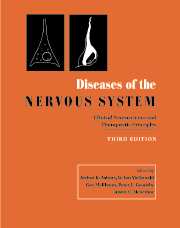Book contents
- Frontmatter
- Dedication
- Contents
- List of contributors
- Editor's preface
- PART I INTRODUCTION AND GENERAL PRINCIPLES
- PART II DISORDERS OF HIGHER FUNCTION
- 13 Congenital disorders of cerebral cortical development
- 14 The aging brain: morphology, imaging and function
- 15 Neurodegenerative diseases
- 16 Aging and dementia: principles, evaluation and diagnosis
- 17 Alzheimer's Disease
- 18 Dementia with Lewy bodies
- 19 Frontotemporal dementia
- 20 Consciousness and its disorders
- 21 Mechanisms of memory and amnestic syndromes
- 22 Acquired disorders of language
- 23 Neglect
- 24 Brain death
- 25 Disorders of mood
- 26 Schizophrenia
- 27 Obsessive–compulsive disorder
- 28 Autism and autistic spectrum disorders
- 29 Attention deficit hyperactivity disorder: spectrum and mechanisms
- 30 The neurobiology of drug addition
- PART III DISORDERS OF MOTOR CONTROL
- PART IV DISORDERS OF THE SPECIAL SENSES
- PART V DISORDERS OF SPINE AND SPINAL CORD
- PART VI DISORDERS OF BODY FUNCTION
- PART VII HEADACHE AND PAIN
- PART VIII NEUROMUSCULAR DISORDERS
- PART IX EPILEPSY
- PART X CEREBROVASCULAR DISORDERS
- PART XI NEOPLASTIC DISORDERS
- PART XII AUTOIMMUNE DISORDERS
- PART XIII DISORDERS OF MYELIN
- PART XIV INFECTIONS
- PART XV TRAUMA AND TOXIC DISORDERS
- PART XVI DEGENERATIVE DISORDERS
- PART XVII NEUROLOGICAL MANIFESTATIONS OF SYSTEMIC CONDITIONS
- Complete two-volume index
- Plate Section
20 - Consciousness and its disorders
from PART II - DISORDERS OF HIGHER FUNCTION
Published online by Cambridge University Press: 05 August 2016
- Frontmatter
- Dedication
- Contents
- List of contributors
- Editor's preface
- PART I INTRODUCTION AND GENERAL PRINCIPLES
- PART II DISORDERS OF HIGHER FUNCTION
- 13 Congenital disorders of cerebral cortical development
- 14 The aging brain: morphology, imaging and function
- 15 Neurodegenerative diseases
- 16 Aging and dementia: principles, evaluation and diagnosis
- 17 Alzheimer's Disease
- 18 Dementia with Lewy bodies
- 19 Frontotemporal dementia
- 20 Consciousness and its disorders
- 21 Mechanisms of memory and amnestic syndromes
- 22 Acquired disorders of language
- 23 Neglect
- 24 Brain death
- 25 Disorders of mood
- 26 Schizophrenia
- 27 Obsessive–compulsive disorder
- 28 Autism and autistic spectrum disorders
- 29 Attention deficit hyperactivity disorder: spectrum and mechanisms
- 30 The neurobiology of drug addition
- PART III DISORDERS OF MOTOR CONTROL
- PART IV DISORDERS OF THE SPECIAL SENSES
- PART V DISORDERS OF SPINE AND SPINAL CORD
- PART VI DISORDERS OF BODY FUNCTION
- PART VII HEADACHE AND PAIN
- PART VIII NEUROMUSCULAR DISORDERS
- PART IX EPILEPSY
- PART X CEREBROVASCULAR DISORDERS
- PART XI NEOPLASTIC DISORDERS
- PART XII AUTOIMMUNE DISORDERS
- PART XIII DISORDERS OF MYELIN
- PART XIV INFECTIONS
- PART XV TRAUMA AND TOXIC DISORDERS
- PART XVI DEGENERATIVE DISORDERS
- PART XVII NEUROLOGICAL MANIFESTATIONS OF SYSTEMIC CONDITIONS
- Complete two-volume index
- Plate Section
Summary
Background and working definition of consciousness
It is generally acknowledged that understanding the neurobiological mechanisms responsible for consciousness is one of the most difficult tasks in the agenda of neuroscience. At first glance, however, the notion of consciousness appears uncontroversial, and it has even been claimed that since everyone is conscious and the notion of consciousness obvious, there is hardly any need to define the phenomenon. Clinicians, neurologists and others tend to believe that determining whether consciousness is present or not is a simple matter. The view presented in this chapter, however, is less optimistic. Although experts and non-experts can come to an agreement on what constitutes the essence of consciousness, the full scope of the phenomena described under that term requires careful consideration and a provisional definition that can guide clinical evaluations and research. Both fundamental scientists and neurologists need a working concept of consciousness, and nothing prevents us from possibly modifying that concept in the future according to new evidence. Moreover, given the particular nature of consciousness, there are no standard neuropsychological tools to assess its impairments, and there may never be. Also, because the study of those phenomena is of recent vintage, we do not have yet available diagnostic imaging procedures for the evaluation of such impairments. For these reasons, the assessment of patients with impairments of consciousness relies primarily on systematic and comprehensive clinical observations, complemented by a good history and by fine structural neuroimaging and electrophysiologic studies.
Whether one consults a good dictionary, a neurology textbook, or a psychology textbook, the current definitions of consciousness one is likely to encounter are fairly similar: the definitions state that consciousness is the ability to be aware of self and surroundings. These are hardly ideal definitions, considering that consciousness is being defined in terms of awareness and that awareness and consciousness are usually regarded as synonyms. In spite of their awkwardness, however, these definitions capture something that we can agree on: ‘consciousness is the ability to know of our own existence and of the existence of objects and events, inside and outside our organism’. inside and outside our organism’.
- Type
- Chapter
- Information
- Diseases of the Nervous SystemClinical Neuroscience and Therapeutic Principles, pp. 289 - 300Publisher: Cambridge University PressPrint publication year: 2002

